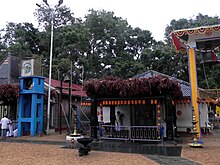| Kataragama temple | |
|---|---|
 Maha Devale/murugan Kovil | |
| Religion | |
| Affiliation | Hinduism |
| Province | Uva |
| Deity | Kathirkaman (Lord Murugan) Nayakan (Sinhalam) |
| Location | |
| Location | Kataragama |
| Country | Sri Lanka |
| Geographic coordinates | 6°25′N 81°20′E / 6.417°N 81.333°E |
| Architecture | |
| Completed | c. 1100 – 15th century[1][2] |
Kataragama temple (Sinhala: රුහුණු කතරගම දේවාලය, lit. 'Ruhuṇu Kataragama Dēvālaya', Tamil: கதிர்காமம் முருகன் கோயில், lit. 'Katirkāmam Murugan Kōvil') in Kataragama, Sri Lanka, is a temple complex dedicated to Buddhist guardian deity Kataragama deviyo and Hindu War God Murugan. It is one of the few religious sites in Sri Lanka that is venerated by the Buddhists, Hindus, Muslims and the Vedda people.[3] For most of the past millennia, it was a jungle shrine very difficult to access; today it is accessible by an all-weather road. The shrines and the nearby Kiri Vehera are managed by Buddhists, the shrines dedicated to Teyvāṉai and Shiva are managed by Hindus and the mosque by Muslims.
The shrine has for centuries attracted Tamil Hindus from Sri Lanka and South India who undertook an arduous pilgrimage on foot. Since the latter half of the 20th century, the site has risen dramatically among Sinhalese Buddhists who today constitute majority of the visitors.[4]
The cult of Kataragama deviyo has become the most popular amongst the Sinhalese people. A number of legends and myths are associated with the deity and the location, differing by religion, ethnic affiliation and time. These legends are changing with the deity's burgeoning popularity with Buddhists, as the Buddhist ritual specialists and clergy try to accommodate the deity within Buddhist ideals of nontheism. With the change in devotees, the mode of worship and festivals has changed from that of Hindu orientation to one that accommodates Buddhist rituals and theology. It is difficult to reconstruct the factual history of the place and the reason for its popularity amongst Sri Lankans and Indians based on legends and available archeological and literary evidence alone, although the place seems to have a venerable history. The lack of clear historic records and resultant legends and myths fuel the conflict between Buddhists and Hindus as to the ownership and the mode of worship at Kataragama.[5]
The priests of the temple are known as Kapuralas and are believed to be descended from Vedda people. Veddas, too, have a claim on the temple, a nearby mountain peak and locality through a number of legends. There is a mosque and a few tombs of Muslim pious men buried nearby. The temple complex is also connected to other similar temples in Eastern Province dedicated to Murugan which are along the path of pilgrimage from Jaffna in the north to Kataragama in the south of the island; Arunagirinathar traversed this pilgrimage route in the 15th century.[6] The vicinity of the temple complex is used for secretive practices of sorcery and cursing peculiar to Sri Lanka (Source or reference to sorcery is missing). The entire temple complex was declared a holy place by the government of Sri Lanka in the 1950s; since then political leaders have contributed for its maintenance and upkeep.
- ^ Cite error: The named reference
Pwas invoked but never defined (see the help page). - ^ Peiris, Kamalika (31 July 2009). "Ancient and medieval Hindu temples in Sri Lanka". Archived from the original on 29 June 2011. Retrieved 6 October 2010.
- ^ Younger 2001, p. 39
- ^ Trainor, Kevin (2004). Buddhism: The Illustrated Guide. Oxford University Press. p. 123. ISBN 9780195173987.
- ^ Wirz 1966, p. 16
- ^ See map.
